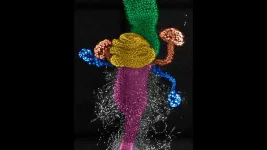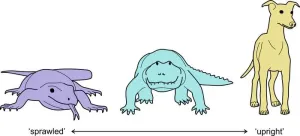(Press-News.org) You have likely not spent much time thinking about the uterus of the fruit fly, Drosophila melanogaster. But then, neither have most scientists, even though Drosophila is one of the most thoroughly studied lab animals. Now a team of biologists at the University of California, Davis, has taken the first deep look at the Drosophila uterus and found some surprises, which could have implications not just for understanding insect reproduction and potentially, pest control, but also for understanding fertility in humans.
The work is published Oct. 25 in Proceedings of the National Academy of Sciences.
Drosophila have been a favorite subject for geneticists and developmental biologists for over a century.
“Drosophila is such a productive system in many ways,” said Rachel Thayer, a postdoctoral researcher working with Distinguished Professor David Begun at the UC Davis Department of Evolution and Ecology. There are extensive catalogs of cell types and genes for most of the fly’s organ systems. But the female reproductive organs – the uterus, female glands and sperm storage organs – have been mostly left out.
Both humans and insects have internal fertilization, so the female reproductive tract has to deal with foreign material from sperm to sexually transmitted viruses. Insects, like many other female animals including birds and reptiles, have organs that can store viable sperm for long periods.
“We wanted to identify all the cell types and their patterns of gene use for these important organs,” Thayer said.
Thayer and Begun, with coauthors Elizabeth Polston and Jixiang Xu, dissected the reproductive tracts of about 150 flies. They were able to separate cell nuclei into individual droplets and label the RNA from each cell with a sort of barcode. By sequencing the RNA, they were able to identify a profile of gene expression from individual cells and sort them into types.
“We can identify the cell types that express certain genes, and where they come from,” Thayer said.
Previously, there were no cell types from the fly uterus identified with genetic markers. The new study reveals more than 20 different cell types in the uterus and associated organs.
“The most exciting thing to me is to find cell types we had not previously predicted would exist,” Thayer said. “This is previously invisible anatomy.”
Supporting sperm storage
The study found that about 40% of genes for “seminal fluid proteins,” previously identified as being made only in male flies, are also expressed in the female fly, especially in sperm storage organs. They may be key to supporting viable sperm for long periods.
Some seminal fluid proteins are thought to manipulate the female fly in ways that benefit the male, such as by delaying the female from mating again. Such sexual conflicts have been the target of considerable, mostly theoretical, study.
“There is dispute about how big a role these sexual conflicts really play, because sexual reproduction still must be collaborative,” Thayer said. The discovery that many of these proteins are made by both male and female flies means that scientists will have to adjust their thinking about these ideas, Thayer said.
“It does not rule out the possibility of molecular sexual conflict altogether, but it does limit how this could occur,” she said.
While reproduction is, obviously, very different in humans and insects, the fruit fly can be a model for understanding animal reproduction at a fundamental level. For example, the seminal fluid proteins could lead to new ways to culture and store human sperm without freezing, which would benefit fertility treatments.
The most numerous species on Earth, insects pollinate and provide other benefits, as well as destroy crops and carry disease. Better understanding insect reproduction could lead to new control strategies.
Thayer is currently working with isolates of Drosophila from around the world to better understand how the flies are evolving in response to environmental stresses, such as climate change and pesticides.
The work was supported by grants from the National Institutes of Health.
END
Invisible anatomy in the fruit fly uterus
New discoveries could have implications for fertility and pest control
2024-10-25
ELSE PRESS RELEASES FROM THIS DATE:
Skeletal muscle health amid growing use of weight loss medications
2024-10-25
A recent commentary published in The Lancet journal highlights the critical importance of skeletal muscle mass in the context of medically induced weight loss, particularly with the widespread use of GLP-1 receptor agonists. These medications, celebrated for their effectiveness in treating obesity, have raised concerns regarding the potential for substantial muscle loss as part of the weight loss process.
Dr. Steven Heymsfield, professor of metabolism and body composition, and Dr. M. Cristina Gonzalez, adjunct and visiting professor in metabolism-body composition, both of Pennington Biomedical Research Center, joined colleagues Dr. Carla Prado of the University ...
The Urban Future Prize Competition awards top prizes to Faura and Helix Earth Technologies and highlights climate adaptation solutions with the inaugural Future Resilience Prize
2024-10-25
NYU Tandon School of Engineering's Urban Future Lab named the winners of its 2024 Future Resilience and Future Solutions prizes, at its 8th annual Urban Future Summit on October 24, 2024 at the Brooklyn Navy Yard in New York City. Through the generous support of The New York Community Trust, MUFG Bank, Mitsubishi Corporation (Americas), the Urban Future Lab continues to catalyze groundbreaking solutions for the climate crisis and this year, they’ve expanded their focus to include adaptation as a critical piece of the puzzle.
After an afternoon of pitches, the jury, comprised of industry experts and ...
Wayne State researcher secures two grants from the National Institute on Aging to address Alzheimer’s disease
2024-10-25
DETROIT – A Wayne State University School of Medicine faculty member has been awarded a total of $2.3 million by the National Institute on Aging of the National institutes of Health for two new, concurrent projects that both address questions related to Alzheimer’s disease, a progressive, age-related degenerative brain disease characterized by memory problems, impaired judgment, cognitive issues and changes in personality.
Joongkyu Park, Ph.D., assistant professor of pharmacology and of neurology, is the principal investigator on “Local protein synthesis ...
NFL’s Bears add lifesavers to the chain of survival in Chicago
2024-10-25
CHICAGO, October 22, 2024— The American Heart Association and the Chicago Bears brought cardiopulmonary resuscitation (CPR) and automated external defibrillator (AED) training to the Illinois High School Association (IHSA) Girls Flag Football State Finals on Saturday, Oct. 19. More than 150 youth athletes, coaches and league administrators learned lifesaving skills building their confidence and capabilities to respond in the event of a cardiac emergency. According to American Heart Association data, 9 out of every 10 people who experience cardiac arrest outside of a hospital die, in part ...
High-impact clinical trials generate promising results for improving kidney health: Part 1
2024-10-25
The results of numerous high-impact phase 3 clinical trials that could affect kidney-related medical care will be presented in-person at ASN Kidney Week 2024 October 23–27.
Finerenone—a selective non-steroidal mineralocorticoid receptor antagonist—has been shown to have kidney protective effects in individuals with chronic kidney disease (CKD) with type 2 diabetes, but its effects on kidney outcomes in patients with heart failure with and without diabetes and/or CKD are not known. To investigate, researchers analyzed data from 6,001 participants enrolled in the FINEARTS-HF trial, a global, randomized ...
Early, individualized recommendations for hospitalized patients with acute kidney injury
2024-10-25
About The Study: Among patients hospitalized with acute kidney injury, recommendations from a kidney action team did not significantly reduce the composite outcome of worsening acute kidney injury stage, dialysis, or mortality, despite a higher rate of recommendation implementation in the intervention group than in the usual care group.
Corresponding Author: To contact the corresponding author, F. Perry Wilson, MD, email francis.p.wilson@yale.edu.
To access the embargoed study: Visit our For The Media website at this link https://media.jamanetwork.com/
(doi:10.1001/jama.2024.22718)
Editor’s Note: Please see the article ...
How mammals got their stride
2024-10-25
Mammals, including humans, stand out with their distinctively upright posture, a key trait that fueled their spectacular evolutionary success. Yet, the earliest known ancestors of modern mammals more resembled reptiles, with limbs stuck out to their sides in a sprawled posture.
The shift from a sprawled stance, like that of lizards, to the upright posture of modern mammals, as in humans, dogs, and horses, marked a pivotal moment in evolution. It involved a major reorganization of limb ...
Cancer risk linked to p53 in ulcerative colitis
2024-10-25
Researchers in the lab of Michael Sigal at the Max Delbrück Center and Charité – Universitätsmedizin Berlin have elucidated the role of the p53 gene in ulcerative colitis. The study, published in Science Advances, suggests a potential new drug target to stop disease progression to cancer.
A team of researchers led by Kimberly Hartl, a graduate student at the Berlin Institute for Medical Systems Biology of the Max Delbrück Center (MDC-BIMSB) and Charité – Universitätsmedizin, have shed new light on the role of the p53 tumor suppressor gene ...
Mass General Brigham experts develop laboratory toolkit for patients with viral hemorrhagic fevers such as Marburg virus disease
2024-10-25
Viral hemorrhagic fevers (VHF) such as Marburg virus disease have been in the news recently, with more than 60 cases of Marburg confirmed in Rwanda. Although there are currently no cases of Marburg in the United States, and the risk of infection in the U.S. remains low, Mass General Brigham experts have collaborated with the U.S. Department of Health and Human Services (HHS) Region 1 Regional Emerging Special Pathogens Treatment Center (RESPTC) at the Massachusetts General Hospital (MGH) to support frontline healthcare facilities in ensuring that patients who are being evaluated ...
Ripples of colonialism: Decarbonization strategies perpetuate inequalities in human rights
2024-10-25
Photos
A University of Michigan study of a city in the Democratic Republic of Congo finds that the necessary process of decarbonization is repeating and recreating colonial inequalities.
The researchers argue that human rights abuses associated with contemporary cobalt mining, such as child labor, social displacement and structural marginalization, are new forms of old colonial practices. Their study is published in the journal Cities.
"We show how those colonial practices emerged through the creation of mining companies and through ...
LAST 30 PRESS RELEASES:
Keck Medicine of USC names Christian Pass chief financial officer
Inflatable fabric robotic arm picks apples
MD Anderson and SOPHiA GENETICS announce strategic collaboration to accelerate AI-driven precision oncology
Oil residues can travel over 5,000 miles on ocean debris, study finds
Korea University researchers discover that cholesterol-lowering drug can overcome chemotherapy resistance in triple-negative breast cancer
Ushikuvirus: A newly discovered giant virus may offer clues to the origin of life
Boosting the cell’s own cleanup
Movement matters: Light activity led to better survival in diabetes, heart, kidney disease
Method developed to identify best treatment combinations for glioblastoma based on unique cellular targets
Self-guided behavioral app helps children with epilepsy sleep earlier
Higher consumption of food preservatives is associated with an increased risk of type 2 diabetes
NTU Singapore-led team captures first-ever ‘twitch’ of the eye’s night-vision cells as they detect light, paving the way for earlier detection of blindness-causing diseases
Global aviation emissions could be halved through maximising efficiency gains, new study shows
Fewer layovers, better-connected airports, more firm growth
Exposure to natural light improves metabolic health
As we age, immune cells protect the spinal cord
New expert guidance urges caution before surgery for patients with treatment-resistant constipation
Solar hydrogen can now be produced efficiently without the scarce metal platinum
Sleeping in on weekends may help boost teens’ mental health
Study: Teens use cellphones for an hour a day at school
After more than two years of war, Palestinian children are hungry, denied education and “like the living dead”
The untold story of life with Prader-Willi syndrome - according to the siblings who live it
How the parasite that ‘gave up sex’ found more hosts – and why its victory won’t last
When is it time to jump? The boiling frog problem of AI use in physics education
Twitter data reveals partisan divide in understanding why pollen season's getting worse
AI is quick but risky for updating old software
Revolutionizing biosecurity: new multi-omics framework to transform invasive species management
From ancient herb to modern medicine: new review unveils the multi-targeted healing potential of Borago officinalis
Building a global scientific community: Biological Diversity Journal announces dual recruitment of Editorial Board and Youth Editorial Board members
Microbes that break down antibiotics help protect ecosystems under drug pollution
[Press-News.org] Invisible anatomy in the fruit fly uterusNew discoveries could have implications for fertility and pest control


